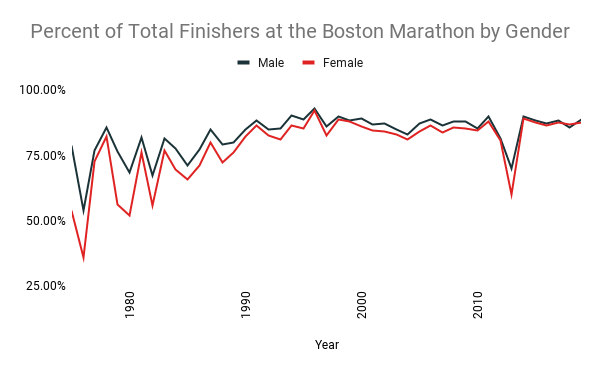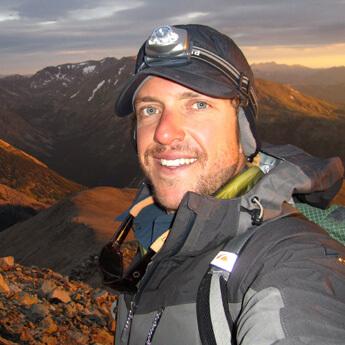The Complete Boston Marathon Database [374 Stats and Facts]
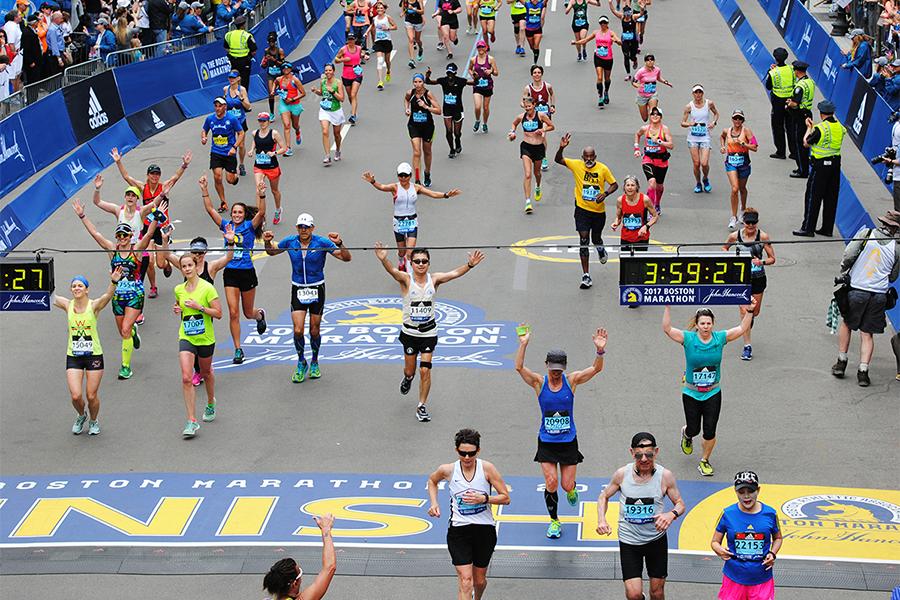
The Boston Marathon is one of the oldest and most prestigious marathons in the world. There's a tonne of work that goes into hosting this immense event, and a tonne of work to gain entry as an athlete.
We’ve scoured the books and are here to present you with the most in-depth information ever about the historic Boston Marathon.
Boston Marathon History
- The Boston Marathon was founded on Monday, April 19, 1897, and was originally called the American Marathon.
- The race was inspired by the success of the first marathon competition in the 1896 Summer Olympics in Athens, which was the first Olympic games held in modern history.
- The original marathon was not 26.2 miles but rater 24.5 miles.
- In 1924 the starting line was moved back to lengthen the race to the current standard marathon length of 26.2 miles to conform with the 1908 Summer Olympics standard.
- The Boston Marathon is the oldest annual marathon in the world.
- Until 2020 Boston was the oldest continuously running marathon, but the race was cancelled due to COVID-19
- The Boston Marathon is the second-longest continuously running footrace in North America, the Buffalo NY Turkey Trot debuted 5 months earlier in November of 1986.
When is the Boston Marathon?
- The Boston Marathon is traditionally held on Patriots' Day, a state holiday in Massachusetts.
- Originally this was on April 19th every year, no matter what day of the week the 19th fell on.
- In 1969 the holiday was changed to always be observed on the third Monday of April which is when the marathon is now affixed to as well.
- The 2020 Boston Marathon was postponed and then cancelled. See more below in the COVID-19 Impacts on the Boston Marathon section.
- The 2021 Boston Marathon was held on October 11th, due to COVID-19 restrictions.
- The 2022 Boston Marathon is scheduled for Monday, April 18.
How many people run and attend the Boston Marathon?
- The first race in 1897 had 15 participants.
- The largest field ever in the Boston Marathon was in 1996 for the centennial running with 38,708 entrants, 36,748 starters, and 35,868 finishers.
- Around 500,000 spectators come to view the Boston Marathon making it the most widely viewed sporting event in New England.
- Since 1975 on average the race is made up of 65.01% men, and 34.98% women.
- In 1975 only 2.2% of the racers were women and 97.8% of the racers were men at the Boston Marathon.
- 2016 saw the highest percentage of female runners at the Boston Marathon with 45.91% of the field being women (54.09% were men).
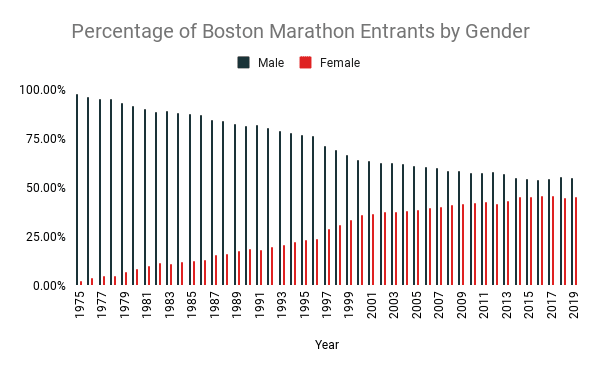
How many people finish the Boston Marathon?
- Since 1975, 84.25% of runners who line up at the start line have finished the Boston Marathon.
- 84.36% of men finish, and 84.04% of women finish the Boston Marathon.
- Since 1975, 1976 saw the lowest finish rate in the Boston Marathon History (53.6% overall), with just 53.7% of men finishing, and only 35.9% of women crossing the finish line.
- The temperature was 100 degrees Fahrenheit an hour before the start of the 1976 race.
- 1996 saw the highest % of finishes in Boston History (since 1975) with 92.66% crossing the line (92.88% men and 91.97% women).
- In 2013 the overall finish race was just 65.58%, (69.91% men and 59.89% women) due to the Boston Marathon bombing.
- 5,633 runners were stopped on the course and did not cross the finish line.
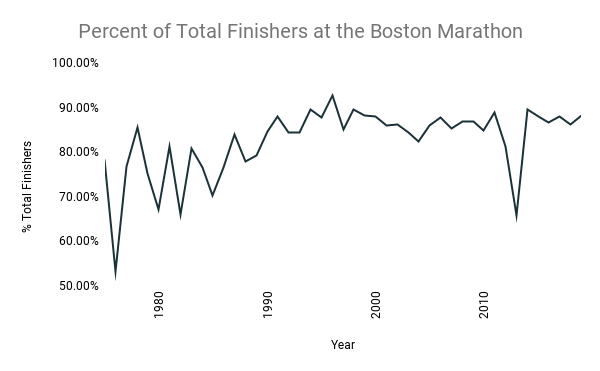
How do you qualify for the Boston Marathon?
- The Boston Marathon is open to runners from any nation that are 18 and over and who meet certain qualifying standards.
- Qualifying times are based on the age bracket you’d be in at the time of the upcoming marathon (not at the time of your qualifying race).
- Qualifying times must be official submitted net times from a Boston qualifying race that’s a full marathon distance within a set period before the race, (usually within approximately 18 months prior).
- Your qualifying time only secures your opportunity to register for the race application process.
- The fastest qualifiers will be accepted first if there are more applicants than spots available.
- Virtual races and indoor marathons do not count as Boston marathon qualifying events.
- The Boston Marathon accepts times from USATF, AIMS, or foreign equivalent certified courses.
- It’s the runner’s responsibility to coordinate with the qualifying race organisers to ensure the course is accepted as a certified Boston Marathon Qualifier.
- Qualifying times are reviewed and verified.
- Through the ’80s and ‘90’s a membership in USATF was required, however, this requirement has been eliminated
- The qualifying times have been adjusted twice. Once in 2013 and again in 2018, reducing each age group’s required time by 5 minutes, altogether lowering the minimum time for each category by 10 minutes.
| Boston Marathon Qualifying Times by Age and Gender | ||
| Age Group | Men | Women |
| 18-34 | 3hrs 00min | 3hrs 30min |
| 35-39 | 3hrs 05min | 3hrs 35min |
| 40-44 | 3hrs 10min | 3hrs 40min |
| 45-49 | 3hrs 20min | 3hrs 50min |
| 50-54 | 3hrs 25min | 3hrs 55min |
| 55-59 | 3hrs 35min | 4hrs 05min |
| 60-64 | 3hrs 50min | 4hrs 20min |
| 65-69 | 4hrs 05min | 4hrs 35min |
| 70-74 | 4hrs 20min | 4hrs 50min |
| 75-79 | 4hrs 35min | 5hrs 05min |
| 80 and over | 4hrs 50min | 5hrs 20min |
Other ways to get an entry into the Boston Marathon
- About 20% of the marathon's spots are reserved for charities, sponsors, vendors, licensees, consultants, municipal officials, local running clubs, and marketers.
- The Boston Marathon allocates charity entries to two dozen organisations that are expected to raise more than $10 million a year.
- Each athlete who participates in the Boston Marathon on behalf of one of the official charities is required to raise a minimum of $5,000.
- In 2017, charity runners raised $34.2 million for more than 200 non-profit organisations.
- The B.A.A.’s official charity programme raised $17.96 million, John Hancock's non-profit programme raised $12.3 million, and the last $3.97 million was raised by other qualified and invitational runners.
Unofficial runners at the Boston Marathon
- The last way to run the Boston Marathon is to join as a “bandit” runner or an unofficial non-registered runner.
- The B.A.A. actually allows this and for decades has had an unofficial last wave for non-registered runners to run the course, and cross the finish line behind the registered athletes.
- The B.A.A. website does not condone or encourage this activity.
Boston Marathon Race Information
Start Times
- Up until 2005 the Boston Marathon traditionally started at noon ((wheelchair race at 11:25 a.m., and elite women at 11:31 a.m.).
- In 2006 the race went to a wave start format with elite runners starting at noon and a second wave at 12:30 p.m.
- In 2007 the race moved the start time up to take advantage of cooler temps and to help get the race over and roads open sooner.
- Since 2007 the Boston Marathon has added additional waves of start times to spread out the runners and avoid over congestion.
| Boston Marathon starting times for 2019 | |
| Men's Push Rim Wheelchair | 9:02 a.m. |
| Women's Push Rim Wheelchair | 9:04 a.m. |
| Handcycles and Duos | 9:25 a.m. |
| Elite Women | 9:32 a.m. |
| Elite Men | 10 a.m. |
| Wave One | 10:02 a.m. |
| Wave Two | 10:25 a.m. |
| Wave Three | 10:50 a.m. |
| Wave Four | 11:15 a.m. |
The Boston Marathon Course
- The official start line for the Boston Marathon is in Hopkinton Massachusetts.
- The official finish line for the Boston Marathon is located at Copley Square on Boylston Street.
- The Boston Marathon is considered to be one of the more difficult marathon courses because of its hilly nature.
- The most notable hill in the Boston Marathon is called Heartbreak Hill and is located between miles 20-21. It’s the last of four hills starting at mile 16 called the Newton Hills as a group.
- Heartbreak Hill rises 88 feet (27 m) vertically (from an elevation of 148 to 236 feet)
- The Boston Marathon Course course drops 459 feet (140 m) from start to finish and heads mostly due east from the start allowing for usual tailwinds
- The Boston Marathon course does not meet the criteria for world record status because the overall elevation loss and the possibility for strong tailwinds go against the World Athletic standards.
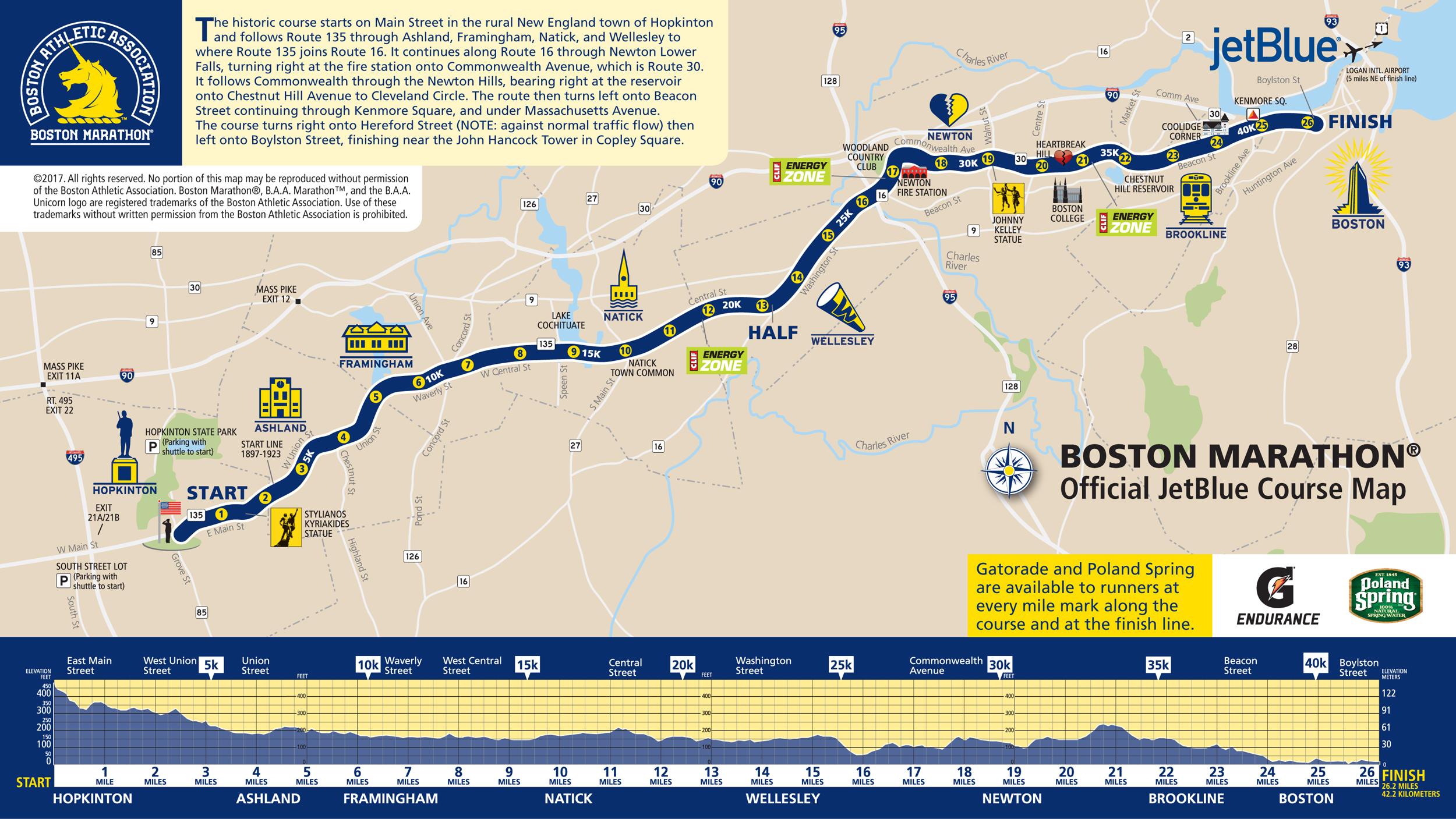
Boston Marathon time limits
- Racers need to maintain a 14:23 minute-per-mile pace to stay ahead of the race closing and sweep vehicles.
- Runners out on the course after the roads reopen are instructed to move to the right side of the road but do not have to quit the race.
- Finish area facilities officially close at approximately 5:30 p.m.
Notable Races and Racers of the Boston Marathon
- The original marathon (1897) was won by John McDermott with a time of 2:55:10 (on a 24.5-mile course).
- In 1966, Roberta Gibb is recognised as the first woman to run the entire Boston Marathon finished in 3:21:40 ahead of two-thirds of the male racers.
- Gibb was refused entry into the race cited that women were physiologically incapable of running 26 miles by the race director.
- In 1967, Kathrine Switzer was the first woman to run and finish with a valid official race registration, registering with just her first initials but with proof of a properly acquired fitness certificate.
- As a result, the AAU changed its rules to ban women from competing in races against men.
- In 2011 Kenyan Geoffrey Mutai's finished the Boston Marathon in 2:03:02, which at the time was the fastest marathon ever run. However, the IAAF (now World Athletics) deemed it not eligible for a world record due to the Boston Marathon course not meeting world record criteria.
- Ethiopian Bezunesh Deba holds the women's Boston Marathon course record with a 2:19:59 performance on April 21, 2014.
- In 2007, astronaut Sunita Williams became the first person to run a marathon in space as an official Boston Marathon entrant but ran the race virtually from the International Space Station.
Other notable finishes
| Other Notable Finishers at the Boston Marathon | |||
| Race | Participant | Time | Year |
| Men's Masters | John Campbell | 2:11:04 | 1990 |
| Women's Masters | Firiya Sultanova-Zhdanova | 2:27:58 | 2002 |
| Men's Push Rim Wheelchair | Marcel Hug | 1:18:04 | 2017 |
| Women's Push Rim Wheelchair | Manuela Schär | 1:28:17 | 2017 |
| Men's Handcycle | Tom Davis | 0:58:36 | 2017 |
| Women's Handcycle | Wendy Larsen | 1:37:15 | 2021 |
Cheating at the Boston Marathon
- In 1980, the first-place women’s finisher, Rosie Ruiz created some suspicion and was later found to not appear in race videotapes until near the end of the race. Ruiz had skipped most of the race and rejoined about a half-mile from the finish line to take first.
Runner deaths at the Boston Marathon
- In 1905, James Edward Brooks died of pneumonia shortly after running the marathon.
- In 1996, Humphrey Siesage, 61, died of a heart attack during the centennial running of the race.
- In 2002, Cynthia Lucero, 28, died of hyponatremia.
- In 2013 three spectators were killed and an estimated 264 were injured when two homemade bombs were detonated near the finish line.
COVID-19 Impacts on the Boston Marathon
- The 2020 Boston Marathon was the first postponement in the event’s history and the race was originally rescheduled from April 20th to September 14th.
- Eventually, the rescheduled marathon was altogether cancelled, the first time the race was not held since 1897.
- The 2020 race was eventually modified into a virtual event for those that wanted to participate remotely.
- The race has been modified once before, in 1918, and changed from the official marathon to a military relay race because of World War One.
- There were 14 teams from different branches of the military consisting of 10 men each which would each run 2.5 miles.
- The Boston Military Relay was run on Friday, April 19, 1918.
| 1918 Boston Marathon Military Relay Race Results (Top 8) | ||
| Place | Team | Time |
| 1 | Camp Devens Divisional Team (Team M) | 2:24:53 |
| 2 | 302d Infantry Camp Devens (Team N) | 2:28:10 |
| 3 | Boston Navy Yard (Team A) | 2:28:45 |
| 4 | 301st Field Signal Battalion Camp Devens (Team O) | 2:29:14 |
| 5 | Naval Cadet School (Team K) | 2:29:23 |
| 6 | 391st Infantry, Camp Devens (Team P) | 2:32:20 |
| 7 | Bumkin Island (Team G) | 2:37:20 |
| 8 | U.S.N Radio School (Team L) | 2:44:26 |
- The 2021 race was also not held in April as usual, it was scheduled for October 11th and limited to just 20K racers.
Who are the Boston Race Series Sponsors?
Principal sponsors for the 4 races (Marathon, Half-Marathon, 10k, 5K)
- The principal sponsor for the Boston Marathon is John Hancock.
- Adidas is the official apparel sponsor of the Boston Athletic Association (B.A.A.).
- The Dana-Farber Cancer Institute and the Jimmy Fund are the presenting sponsors for the B.A.A. Half Marathon.
- Brigham and the Women’s Hospital are the presenting sponsors for the B.A.A. 10K.
- Special Olympics of Massachusetts is the official fundraiser for the B.A.A. 5K.
Official sponsors of the Boston Marathon
- Amazon
- Gatorade Endurance
- Poland Springs
- Samuel Adams
- Citgo
- TCS (Tata Consultancy Services)
- Abbott
- jetBlue
- Wanda Sports Group
- Maurten
- Newton-Wellesley Hospital
- Olive
- iFit
- NBCSN
- WBZ4
- Doug Flutie Jr. Foundation for Autism
- Quest Diagnostics
- Oppo
More Marathon Info
Want to know more about the Boston Marathon and the other 5 Marathon Majors? Check out our other posts on the subject:
- World Marathon Majors [93 Stats & Facts]
- How to Qualify for a Major Marathon [234 Stats and Facts]
- What is a Six Star Marathon Finisher [146 Stats & Facts]
About RunRepeat
The Boston Marathon is one of the oldest and most prestigious races in the world. It takes a lot of work to get into the Boston Marathon and RunRepeat is here to help you find the right shoes for race day. Whether it’s marathon shoes, race-specific shoes, or carbon-plated shoes we test them all: we run in them and we cut them in half in our lab. In the lab, we use our microscope, callipers, durometer, force gauge, dremmel, band saw, scalpel, smoke pump, and other instruments to properly and objectively examine every little piece of a running shoe.
Interested in learning more about shoes? Check out our shoe buyer’s guides or our pages on road running shoes, trail running shoes, or even just trainers.
Use of content
- We are happy to give interviews on the topic at any time. For this purpose or for print-use questions please reach out to Paul Ronto at paul@runrepeat.com.
- Feel free to use material from this page in any web coverage of the topic, we just ask that you refer, and link back to this original source.
References
- https://www.baa.org/partners/sponsors
- https://www.baa.org/races/boston-marathon
- https://en.wikipedia.org/wiki/Boston_Marathon
- https://www.baa.org/races/boston-marathon/enter/course-information
- https://en.wikipedia.org/wiki/Marathon_world_record_progression#Criteria_for_record_eligibility
- https://www.baa.org/races/boston-marathon/results/participation
- http://www.runningpast.com/baa1918relay.htm
